Alexandra E. Bello

As Bitcoin approached $70,000 in November 2021,[1] cryptocurrency enthusiasts were exuberant about blockchain technology and the rise of digital currency. The crypto craze calmed substantially in the months that followed,[2] however, and it wasn’t long before crypto exchanges Celsius, Voyager and FTX filed for bankruptcy.[3] Collectively, they owe customers over $9 billion.[4] Naturally, calls to improve the regulation of digital financial markets have followed.[5]
By contrast, innovators in the agriculture and health care industries have successfully integrated blockchain, the technology that underlies cryptocurrency, without controversy or new regulatory frameworks. The so-called ag-tech and health tech sectors are also attracting significant investment. In 2021, they received $11.4 billion and $29.1 billion, respectively, in venture capital funds.[6]
This issue brief outlines how blockchain technology is transforming the current business landscape — particularly the agricultural and health care sectors. Through its ability to provide both transparency and security, blockchain is being used by agricultural and health care companies to enhance interoperability, traceability and efficiency.
What Is Blockchain?
A blockchain is a digital database containing information that can be simultaneously used and shared within a decentralized network.[7] Participants can confirm transactions without a need for a central clearing authority.
According to consulting firm PwC, blockchain can be thought of as a next-generation business-process improvement software with the potential to improve efficiency and reduce costs, especially for businesses.[8] The technology has a wide range of potential applications, from financial services to logistics.
Problems in Agriculture: Transparency and Safety
In the agriculture industry, blockchain technology is one form of ag-tech being deployed to satisfy consumer preferences and improve product safety. According to a report by IBM and the National Retail Federation, purpose-driven consumers — who choose products and brands based on how well they align with their values — now represent the largest segment (44%) of shoppers globally.[9] Nearly 70% of purpose-driven shoppers prefer to buy sustainable, organic or environmentally responsible products, and they spend considerable time researching brands. Though their demands may seem daunting for businesses, purpose-driven consumers are ideal shoppers for several reasons: Compared to other segments of shoppers, purpose-driven consumers are more likely to impulse shop, to buy more than what’s on their shopping list and to share their brand preferences with friends and family. (See Figure 1.) Ignoring purpose-driven consumers means losing shoppers who make up an enthusiastic and lucrative segment of the market.[10]
Figure 1 — Purchasing Power Among Purpose-driven Consumers
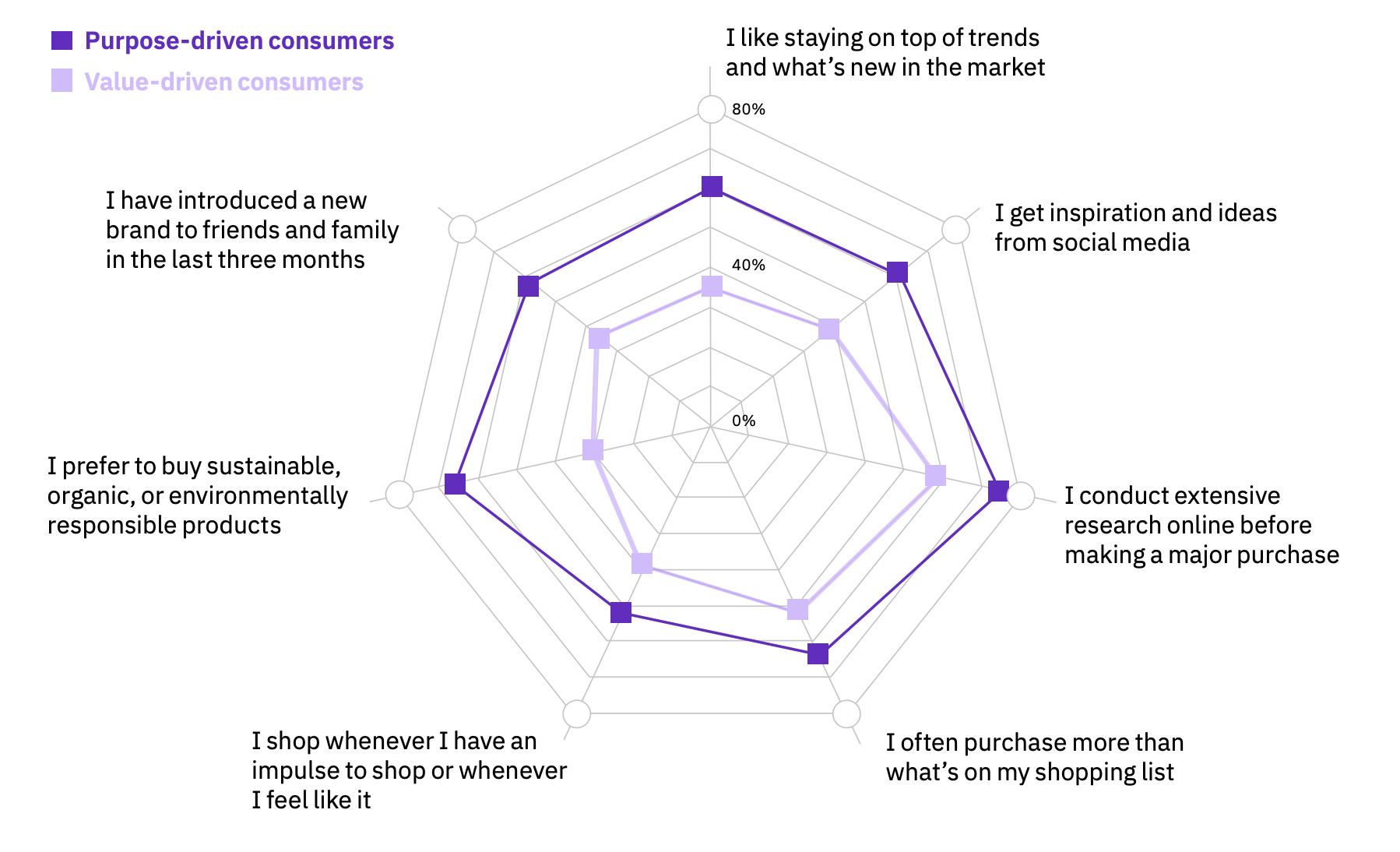
Source Karl Haller et al., “Consumers want it all,” IBM Institute for Business Value, https://www.ibm.com/downloads/cas/YZYLMLEV.
In addition to sustainability and other environmental considerations, food safety lapses present another concern for consumers. The Centers for Disease Control and Prevention (CDC) estimates that there are 48 million cases of foodborne illness every year in the United States from 31 known pathogens and other agents,[11] and that foodborne illnesses contribute to over 3,000 deaths.[12] For these reasons, both public- and private-sector stakeholders are interested in prioritizing food safety.
The Food Safety Modernization Act (FSMA) was adopted in 2011 to focus public and private resources on preventing foodborne illnesses. Notably, the FSMA required the development of enhancements for recordkeeping and the tracking and tracing of food. It also called for pilot projects in coordination with the food industry to “evaluate methods to rapidly and effectively identify recipients of food to prevent or mitigate a foodborne illness outbreak” through “the development and demonstration of appropriate technologies.”[13] Building on the principles of the FSMA, the Food and Drug Administration (FDA) released its 2020 report “New Era of Smarter Food Safety” to outline its future food safety approach. In the report, the FDA emphasizes the importance of tech-enabled traceability and the development of smarter tools for prevention and outbreak response.[14] It also specifically acknowledges blockchain as a plausible way to “receive critical tracking events and key data elements from industry and regulatory partners.”[15]
Blockchain Solutions: Improving Transparency and Safety in Agriculture
In order to meet demands for sustainability and transparency, companies are actively adopting blockchain technology. For example, IBM Food Trust, a blockchain-based food traceability platform, allows consumers to access specific information regarding food safety, freshness and farming practices. All data is stored on blockchain ledgers protected by commercial-grade encryption.[16] Transaction partners, such as farmers, manufacturers and suppliers, can enter specific information about a product over the course of its journey from farm to table. This data improves the food supply chain in seven key areas:Supply chain efficiency. Data is used to forecast demand, enabling businesses to grow.
Brand story. End-to-end traceability empowers consumers to buy food that meets their values, including organic or sustainably grown products.
Food freshness. Accessible harvesting, transportation and temperature data helps identify inefficiencies and improve freshness.
Food safety. The ability to quickly trace products mitigates the spread of foodborne illnesses.
Food fraud. Storing records in a decentralized and immutable manner reduces fraudulent claims.
Waste reduction. In the event of a food recall, grocery stores are able to pinpoint affected products and reduce food waste.
Sustainability. The digitization of documentation ensures product authenticity, especially for products purportedly grown in certain regions or through specific environmentally conscious processes.
A blockchain’s unique ability to provide both transparency and security makes it a valuable tool for businesses. With purpose-driven consumers now representing the largest segment of shoppers, companies that deliver sustainable, environmentally conscious products have a competitive advantage. Additionally, businesses using blockchain technology can leverage real-time data to improve efficiencies and reduce waste, improving their bottom line. IBM Food Trust is priced at $100 per month for businesses with less than $50 million in revenue, $1,000 per month for businesses with up to $1 billion in revenue and $10,000 per month for business giants.[17] The cost appears to be worth it to industry leaders Walmart, Nestlé, California Berry Farms and Carrefour,[18] all of which have adopted the platform.
Expanding and Funding Ag-tech
Regulatory agencies are also encouraging the adoption of blockchain. In 2021, the FDA issued the “Low- or No-Cost Tech-Enabled Traceability Challenge” as part of its smarter food-safety initiative (see Figure 2). The agency received 90 submissions from around the world and selected 12 winners to present their entries in a public forum hosted by the FDA. Three of the winners — Atma.io, TagOne and Wholechain — utilized blockchain technology.[19] Launched by packaging giant Avery Dennison, Atma.io already manages over 22 billion items on its platform.[20] TagOne provides real-time tracking to businesses in the food and beverage, supplement and CBD industries.[21] Wholechain focuses on responsible ingredient sourcing, most recently partnering with beauty brand Aveda to trace Madagascar vanilla in its products.[22] All three winners are leveraging blockchain’s unique ability to improve transparency via a decentralized, immutable ledger.
Figure 2 — Low- or No-cost Tech-enabled Traceability Challenge
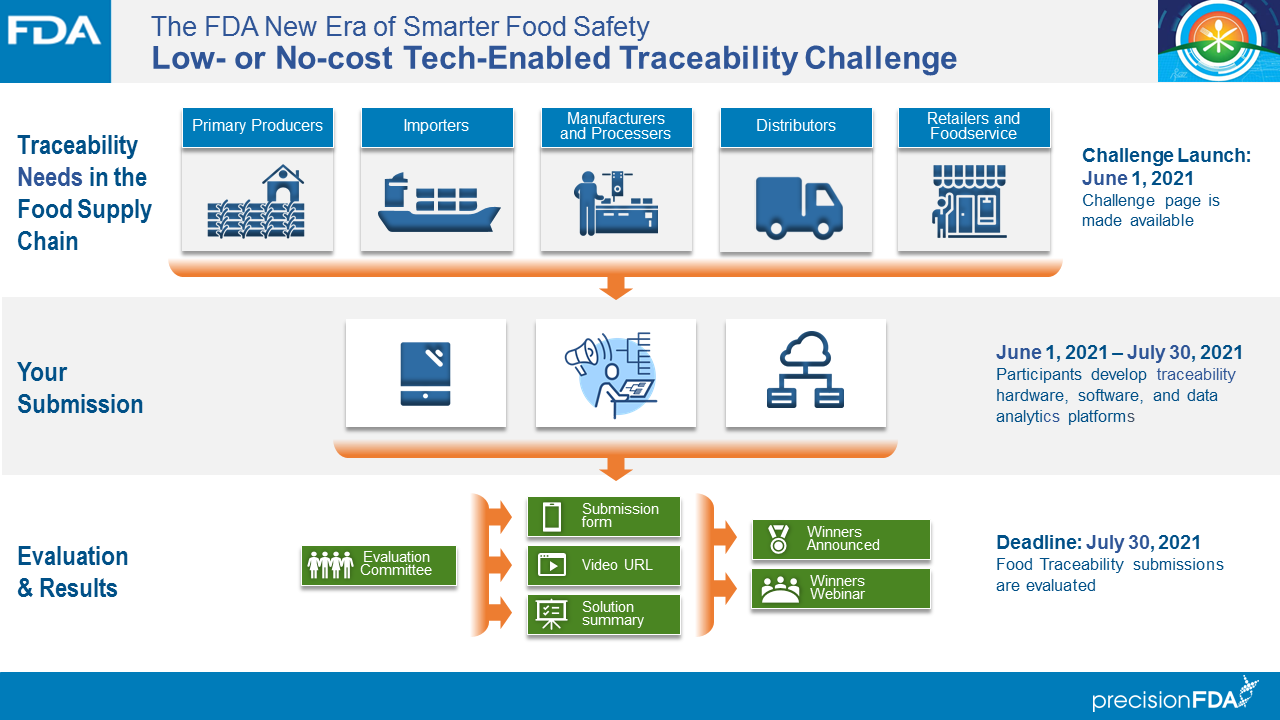
Source PrecisionFDA, “The FDA New Era of Smarter Food Safety Low- or No-Cost Tech-Enabled Traceability Challenge,” accessed October 3, 2022, https://precision.fda.gov/challenges/13/results.
Venture capital funding for ag-tech grew to $11.4 billion in 2021.[23] Its growth has been largely driven by supply chain challenges and consumer-led pushback over traceability. Bayer’s crop science division and Amazon Web Services are currently partnered with BlockApps, an enterprise blockchain provider that has raised over $40 million in funding[24] and is the creator of TraceHarvest, a blockchain application that traces the full life cycle of agricultural products. TraceHarvest is designed to assist farmers, manufacturers, distributors and processors with “supply chain efficiencies, transparency, compliance and stewardship.”[25] In addition to blockchain technology, venture capitalists are expected to invest in farm management software, smart field equipment and field IoT (internet of things).[26]
Figure 3 — Ag-tech Venture Capital Deal Activity (2011-2021)
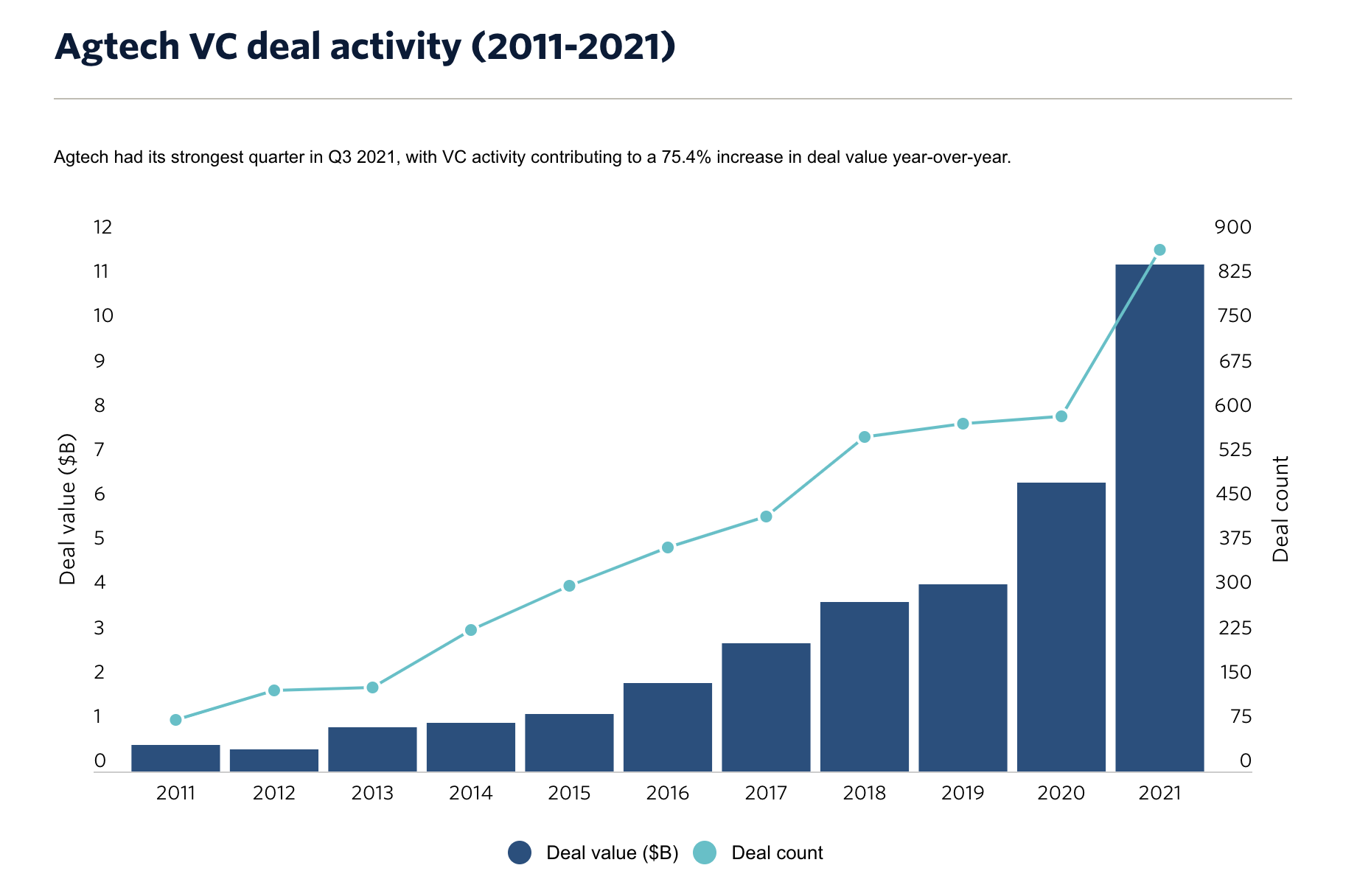
Source Plamena Malinova, “Agtech and the future of sustainable food production,” Pitchbook (blog), last modified July 21, 2022, https://pitchbook.com/blog/agtech-and-the-future-of-sustainable-food-production.
Problems in Health Care: Product Verification, Contracts and Charge-backs
Meanwhile, health care companies are deploying blockchain technology to meet the requirements of the 2013 Drug Supply Chain and Security Act (DSCSA) for prescription drug traceability.[27] Beginning in 2023, the DSCSA will require interoperable, electronic tracing of pharmaceutical products at the package level.[28]
When manufacturers, wholesalers and group purchasing organizations (GPOs) do not communicate effectively, errors occur. The current systems are not instantaneous, which contributes to pricing discrepancies among stakeholders. Correcting these mistakes requires the manual entry of returns, credits and resubmissions. This time-intensive process drags out payment cycles for manufacturers, wholesalers and GPOs alike, resulting in higher individual payments and the potential for outstanding balances to accumulate interest. Both outcomes are undesirable for businesses wanting to maintain optimal cash flow.
A Blockchain Solution for Health Care: The MediLedger Network
The MediLedger Network leverages blockchain technology to be the “ultimate privacy-first platform for healthcare trading partner transactions.”[29] Its goal is to establish alignment, accuracy, privacy and decentralization among its members,[30] which include biotech, pharmaceutical and distribution companies. Chronicled, the network’s custodian, remains responsible for developing solutions on the network and authenticating new users.[31] In 2019, MediLedger joined a cross-industry pilot program by the FDA intended to evaluate blockchain solutions with potential to meet DSCSA requirements.[32]
Using blockchain technology, MediLedger allows product verification to happen in under a second. This enables quick and safe movement of pharmaceutical products through the supply chain. In the event of a merger or acquisition, the global trade item number (GTIN) on a pharmaceutical product can be transferred seamlessly via the blockchain from one manufacturer to another;[33] this quick transfer allows distributors to verify the product immediately, preventing delays.
Chronicled also tackles charge-back and contract issues through the MediLedger Network. Its roster system securely integrates customer identity data in real time, reducing charge-back disputes and pricing errors. MediLedger also increases price accuracy by facilitating real-time contract-sharing between manufacturers, wholesalers and GPOs. In addition, its use of the blockchain enables auto-adjudication to manage returns, credits and resubmissions. By eliminating manual errors, payment cycles are shortened, promoting optimal cash flow for businesses.
Figure 4 — MediLedger Network DSCSA 2023 Proposal
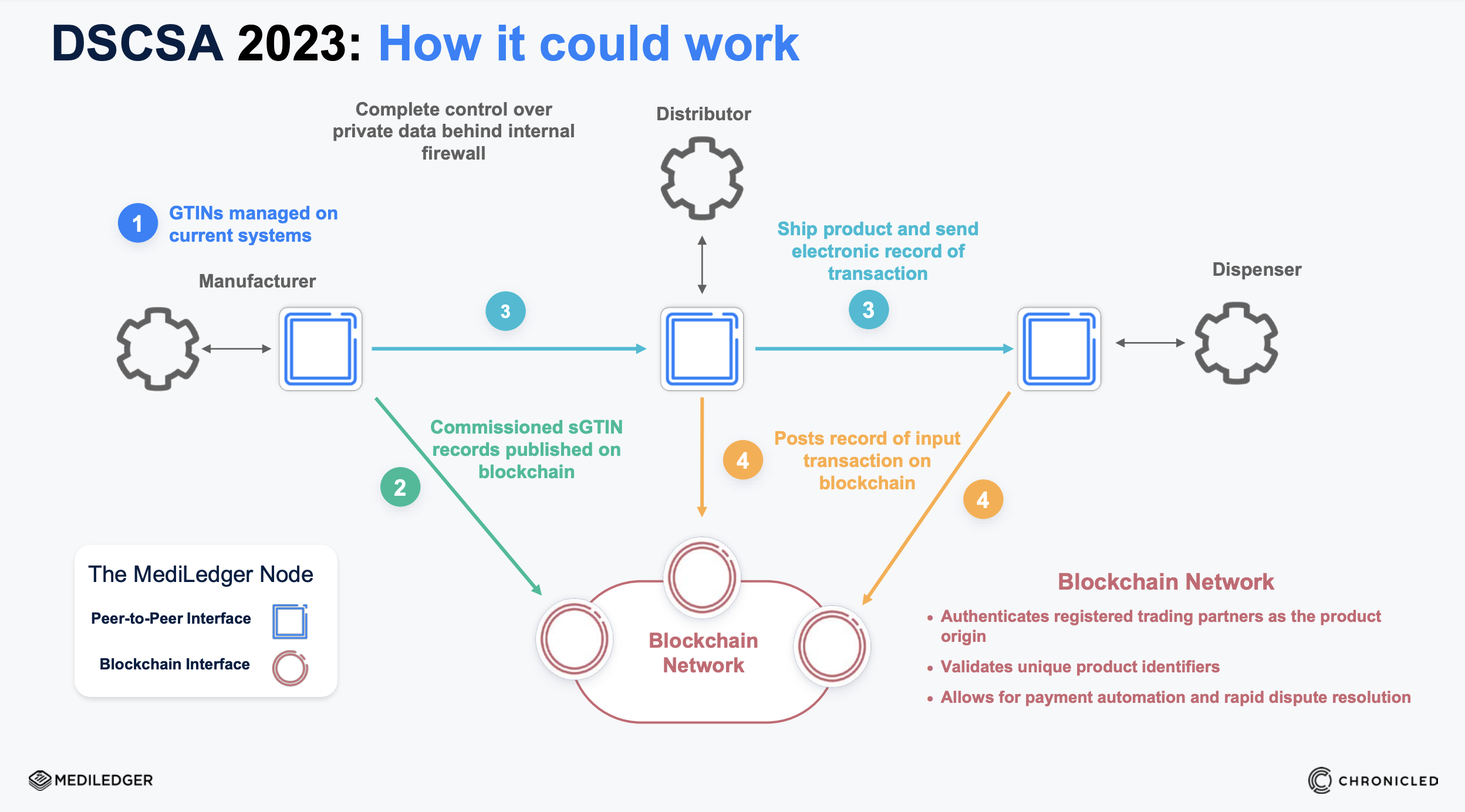
Source U.S. Food and Drug Administration, DSCSA Pilot Project Program Participant Results, https://www.fda.gov/media/147173/download.
Expanding and Funding Interoperable Systems
Chronicled has raised $36.3 million over 10 rounds of funding.[34] Most recently, venture capital fund True Global Ventures 4 Plus (TGV) invested $8.3 million in the company. TGV founding partner and director Dušan Stojanović noted, “We have invested substantially in Web3 in the gaming and entertainment sector where interoperability is and will be key. We see some of these trends being as important if not more important in the pharma Web3 industry.”[35] It is clear that interoperable systems have the potential to reduce medical errors and improve care. Directing more funding toward these pursuits is an important step in creating an efficient health care system.
Venture capital firm Portfolia also contributed to Chronicled’s Series A funding round.[36] Founded by Trish Costello in 2013, Portfolia creates investment funds designed for women and backs innovative companies for returns and impact.[37] Prior to founding Portfolia, Costello co-founded the prestigious Kauffman Fellows Program, which trains venture capitalist partners.[38] Portfolia is also an investor in B.well, a digital platform focused on health care interoperability,[39] and Xandar Kardian, whose home health-monitoring system automatically collects and shares data with an individual’s physician.[40]
Portfolia is not the only venture capital firm interested in health tech. In 2019, digital health start-ups raised $8.2 billion.[41] Driven largely by the pandemic, that number rose to an all-time high of $29.1 billion in 2021.[42] McKinsey & Company has identified five key categories where health tech could be implemented: research and development, wellness and disease prevention, screening and diagnosis, care delivery, and finance and operations.[43] With the potential to reduce health care costs by $500 billion, digital health interventions are expected to see even more funding in the future.[44]
Figure 5 — U.S. Digital Health Funding and Deal Size
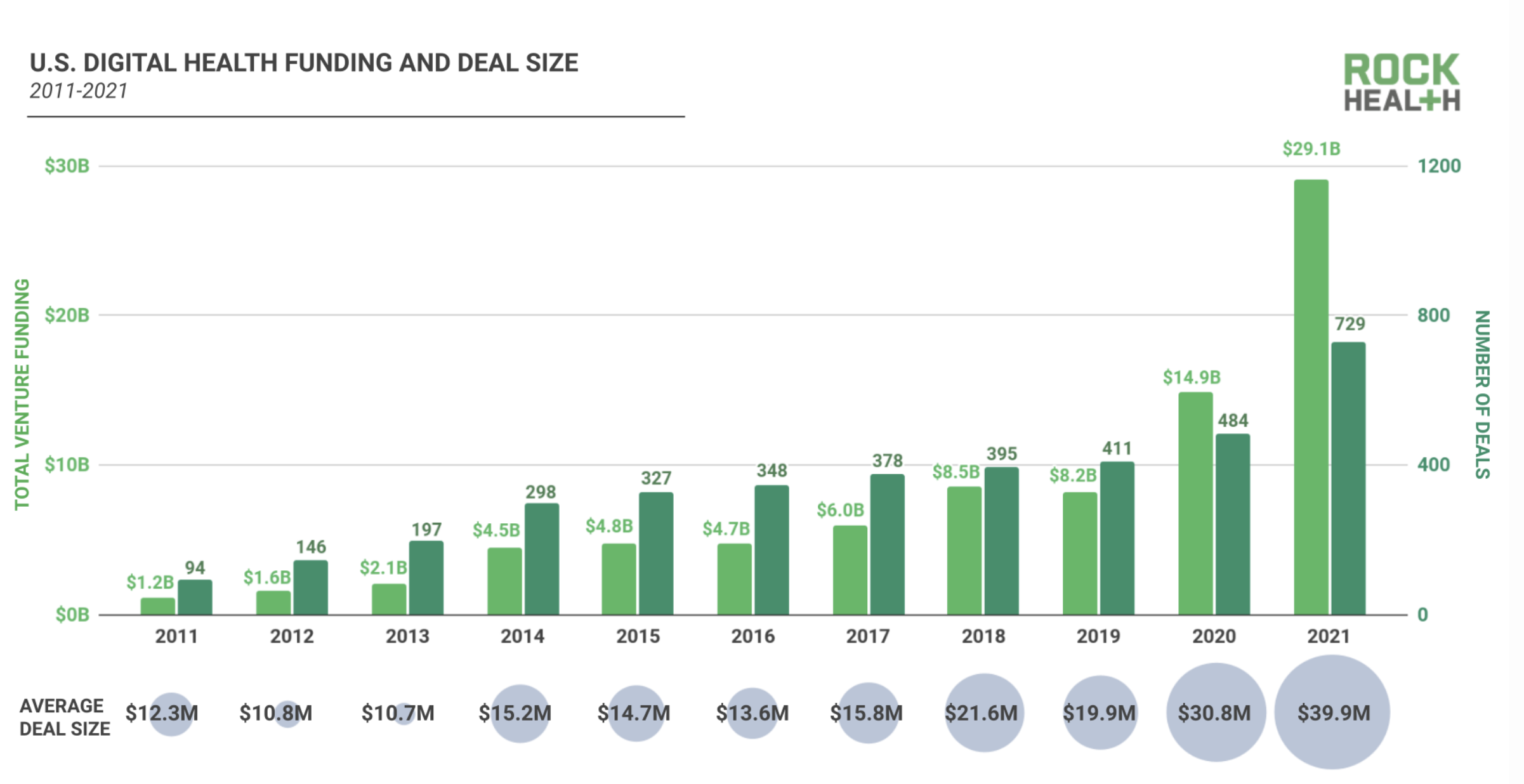
Source Rock Health, 2021 year-end digital health funding: Seismic shifts beneath the surface," last modified January 10, 2022, https://rockhealth.com/insights/2021-year-end-digital-health-funding-seismic-shifts-beneath-the-surface/.
Conclusion
Investors are backing health tech and ag-tech companies at a growing rate, highlighting demand for improved agricultural and health care systems. In order to meet demands for sustainability and transparency within the food industry, private and public stakeholders are allocating resources to build and implement blockchain solutions; blockchain technology is also useful for drug manufacturers and wholesalers, as it eliminates the manual effort needed to verify customer and pricing information. By auto-verifying information against the blockchain ledger, pricing data is available in real time, reducing wait times for medicines.
Cryptocurrencies may remain volatile investments, but the blockchain technology that enables them has successfully embedded itself into the current business landscape — and companies that are able to leverage blockchain technology to increase traceability and interoperability can expect future success.
No comments:
Post a Comment